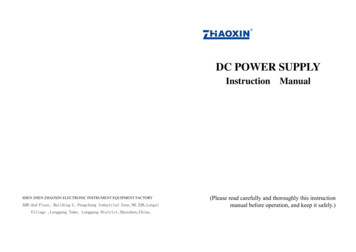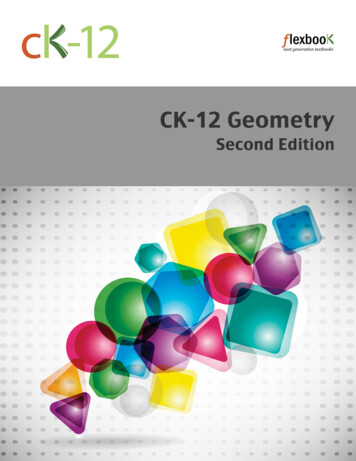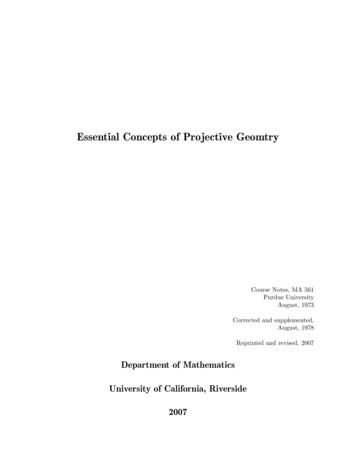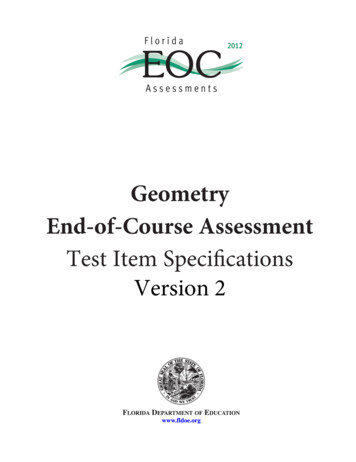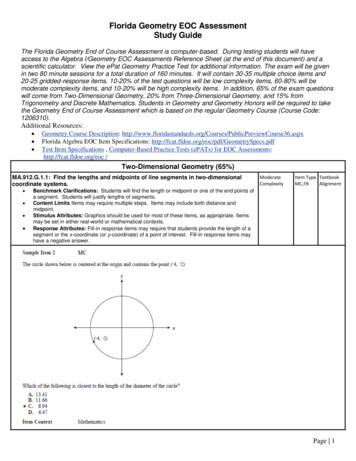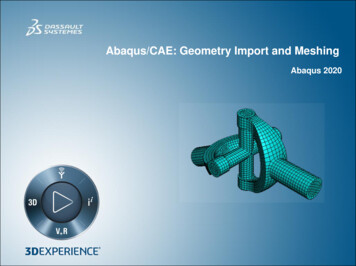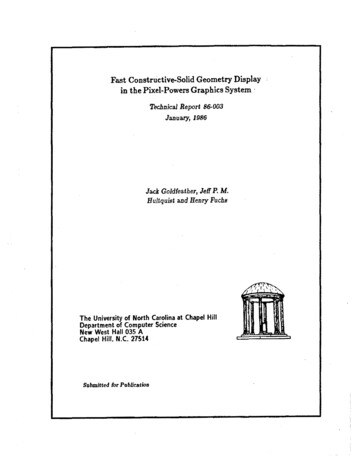
Transcription
Fast Constructive-Solid Geometry Displayin the Pixel-Powers Graphics System ·Technical Report 86-003January, 1986Jack Gold(ea.tber, Je!I P. M.Hultquist and Henry FucbsThe University of North Carolina at Chapel HillDepartment of Computer ScienceNew West Hall 035 AChapel Hill. N.C. 27514Submitted for PublieatioD
Fast Constructive-Solid Geometry DisplayIn the Pixel-Powers Graphics SystemJack GoldfeatherCarleton College, Northfield, MNJeff P.M. HultquistHenry FuchsUniversity of North Carolina at Chapel HillABSTRACTWe present two algorithms for the display of CSG-defined objects on Pixel-Powers, an extension of thePixel-Planes logic-enhanced memory architecture, which calculates for each and every pixel on the screen (inparallel) the value of any quadratic function in the screen coordinates (x,y). The first algorithm restructuresany CSG tree into an equivalent, but possibly larger, tree whose display can be achieved by the secondalgorithm. This second algorithm traverses the restructured tree and generates quadratic coefficients andopcodes for Pixel-Powers. These opcodes instruct Pixel-Powers to generate the boundaries of primitivesand perform set operations using the standard Z.bulfer algorithm. Although we have not yet needed toinvoke the restructuring algorithm, since all the CSG trees we have analyzed so far have turned out to be"simply-structured" already, the restructuring algorithm may also be useful for other systems that wish toguarantee the display, with limited pixel storage, of a.ny pOt!sible CSG tree.Several externally-supplied CSG data sets have been processed with the new tree-traversal algorithmand an associated Pixel-Powers simulator. The resulting images indicate that good results ca.n be obtainedvery rapidly with the new !!Yl'tem. For example, the commonly ued Meeserschmitt bracket [Okino 85] with24 primitives is translated into approximately 1900 quadratic coefficients. On a Pixel-Powers system runningat lOMHz (the speed at which our current Pixel-Planes memories run), the image should be rendered inabout 7.5 milliseconds.Goldfeather, Hultquist, Fuchs: Fast CSG Display in Pixel-Powers- page 1
I. IntroductionWe are designing a graphics system called Pixel-Powers, which enhances the Pixe1-Planes system !Fuchs85] [Poult 85] by replacing the multiplier tree that evaluated linear expressions by one that evaluates quadraticexpressions !Goldf 86]. This quadratic expression evaluator (QEE) is used to evaluate expressions of the formAx' Bzy O"lf Dx Ey F simultaneously for each pixel (x,y) on the screen. We estimate that theQEE will calculate bit-sequentially a SO bit value of this expression for each and every pixel on the screenin under 4 microseconds. The speed at which Pixel-Powers can render convex polyhedra, as well as smoothshaded cylinders, cones, and ellipsoids, has led us to explore the possibilities of using Pixel-Powers for realtime rendering of smooth.haded CSG objects constructed from quadratic primitives. A Constructive SolidGeometry (CSG) object is defined by starting with a set of solid primitives and constructing a binary treein which the leaves are primitives and the non-leaf nodes are set operations. The CSG object is constructedrecursively by performing the set operation on the objects defined by the left and right subtrees. {Requi 80]In this paper we describe a general method for displaying any CSG object using a frame buffer .that is128 bite deep. Our method dilfers from other CSG display methods fAther 83) in that we compute on the flythe boundary representation of each primitive in terms of the viewpoint. While this can be a disadvantagein some systems, we will show how it can be implemented efllcient)y in Pixel-Powers by making use of thequadratic expression evaluator and the general parallelism of the system. In particular, we will describe analgorithm for fast rendering of smooth-shaded CSG objects based on quadratic primitives. Our approach,parallel on all pixels but processing CSG primitives sequentially, contrasts with another system by Kedem[Kedem 84] that allocates a processing element for each primitive and renders the images sequentially bypixel in raster-sean order.Just as in the development of the Pixel-Planes system, we have implemented software simulators thatenable us to develop display algorithms before the actual chip is completely designed a.nd committed tosilicon. All of the images in this paper are from the Pixel-Powers simulator.Goldfeather, Hultquist, Fuchs: Faot CSG Display in Pixel,. Powers- page 2
n. ASimple ExampleIn this section we describe a method for displaying any CSG object with the aid of a. deep frame buffer.The present working Pixel-Planes syatem has a 72 bit deep frame buffer. A Pixel-Powers system with a depthof 128 bits was our model when we were analyzing the problem, but there is no reason that the a.lgorithmcould be implemented in any computer with a deep frame buffer. The memory requirements are (figuresl(a), l{b), and 1(c):(a)Two depth buffers: ZTEMP and ZMIN (20.30 bits each)(b)Three ftag registers: Fl, F2, and F3 (one bit each)(c)One Color buffer: COLOR {24 bits) (If double buffering is desiredtwo color buffers are needed)We defer until Section ill and V the discussion of the particular Pixel-Powers implementation of thesealgorithms for CSG objects defined with convex primitive solids whose boundary surfaces can be definedusing quadratic and/or linear equations in x,y, and z (e.g. cylinders, ellipsoids, and cones). In this sectionwe outline a general method of display that will work for any set of convex primitives and any display systemthat can do both of the following:(a) Scan convert front and back facing surfaces of each primitive in screen space. That is, a llag F ateach pixel can be set to 1 if it is inside the region on the screen determined by the projection of the surfaceon the screen. Note that the front and back face of a aurface depends on the viewpoint. In this paper,the front surface of a cylinder consists of all points on the cylinder surface (including the ends) which facetoward the viewer.(b) Calculate and store in each pixel me,mory with F l the depth and color values of the front or backfacing surfaces of a primitive.Goldfeather, Hultquist, Fuchs: Fast CSG Display in Pixel-Powers -page 3
In Section In, a general a.lgorithm is derived b . ed only on the ""sumptions (a) and (b) above. Weillustrate the ide"" behind this algorithm by examining the simple cases of union, difference, and intersectionof two cylinders.D. a. Cylinderl U Cylinder2This is displayed by applying the standard Z-buffer a.lgorithm. H Front(obj) denotes the (viewpointdependent) visible part of the surface of an object, then Front(Cylinderl} will, in general, be the visiblepart of the curved portion of the cylinder together with one of the two planar ends (figure 2(a)}. We beginby calculating the Z values and color values of Front(Cylinderl) and storing them in ZMIN and COLOR.Because later in this paper we will be decomposing more complicated objects into unions of simpler ones,we will describe carefully now how Cylinder2 is added to the partial image:Step 1: At each pixel, set the flag Fl ii it is inside the region determined by Front(Cylinder2), anddear it otherwise (figure 2(a.)).Step 2: Calculate and store Z values for Front(Cylinder2} in ZTEMP.Step 3: For each pixel with Fl set, compare ZTEMP to ZMIN and if ZTEMP ZMIN then dear Fl.Step 4: For each pixel with Fl still set, replace the contents of COLOR with the color of Cylinder2(ligures 2(b) and 2(c)).Note that this algorithm does not depend on the nnioned objects being primitive. As long as scanconversion, depth values, and colors ean be calculated, any objects ean be unloned together by this simplemethod. This same technique of composing objects with -buffers has been used in many previous systems.Goldfeather, Hultquist, Fuehs: Fast CSG Display in Pixel-Powers -page l
II. b. Cylinderl- Cylinder2This can be displayed by first recognising that its image is identical to the image of (Front( Cylinderl J-Cylinder2) U (Back(Cylinder2) n Cylinder!). The general algorithm for generating ouch decompositions isdescribed in Section IV. AB we saw in the union process above, it suffices to generate the first term in theunion and then add the second term to this partial image. The first term, Front(Cylinder1)- Cylinder2 isgenerated as follows:Step 1: Set Fl for all pixels inside the projection of Cylinderl onto the screen (figure 3(a)).Step 2: Store the depth of Front(Cylinderl) in ZTEMP for pixels at which Fl is set.Step 3: Clear Flat any pixel which is inside Cylinder2. A pixel (x,y) is inside Cylinder2 if its ZTEMPlies between the Z values of Front(Cylinder2) and Back(Cy/inder2) (figure 3(h)). What now remains isthe front boundary of the first cylinder.Step 4: We now tranafer the value of ZTEMP to ZMIN for each pixel at which Fl is set. For thesesame pixels, we update the contents of COLOR with the color of the Front(Cylinder1) at that location.This completes the display of Front(Cy/inder1)-Cylinder2. Next we a.dd Back(Cylinder2)nCylinder1to this partial image.Step 5: Set Fl for all pixels inside the projection of Oylinder2 on the screen (figure 3(d)).Step 6: Store the depth of Back(Cylinder2) in ZTEMP for those pixels in which Fl is set.Step '1: Clear Fl for all pixels which are outside Cylinder!. These are the pixels for which ZTEMP doesnot lie between the eorresponding values of Front( Cylinder!) and Back(C!!linder1). What now remainsare the pixels which display th back wall of the hole whleh Cylinder2 bores into Cylinder! (figure S(e)).Goldfeather, Hultquist, Fuchs: Fast CSG Display in Pixel-Powers- page 5
Step 8: For th- pixels, we clear Fl if ZTEMP ZMIN. We now transfer the value of ZTEMP toZMIN for "ach pixel at which Fl rema.in.B set. For these same pixels, we npda.te the contents of .COLORwith the color of the Bacle(Cylinder2) a.t that location (figure 3(f)).ll.c. Oylinder1 n Cylinder2This can be decomposed into (Front(Cylinderl) n Cylinder2) u (Front(Cylinder2) n Cylinderl). Theterms in this union are generated in a ma.nner similar to the terms in the decomposition of the difference ofthe cylinders.This procedure generalises for arbitrary objects defined by CSG trees. The basic idea is that an arbitraryCSG tree ca.n be quickly modified so tha.t nothing more complicated tha.n a. primitive is ever removed from orintersected with the object that is crea.ted by traversing the CSG tree. However, before describing in SectionIV how this is done, we wa.nt to outline how the display algorithm can be implemented in Pixel-Powers.m. The Example Implemented with Pixel-PowersWe will see in the following sections that this method is particularly llllitable for implementation ina machine such as PixeJ,.Powers that has a small fixed amount of memory at each pixel. The dramaticspeed in Pixel-Powers is due in large part to the Quadratic Expreasion Evaluator which evalua.tes quadraticexpressions in x andy simultaneously at each pixel The architecture of this Evaluator is more fully describedin !Goldf 86]. For the purposes of this discuasion, it is sufficient assert that the Pixel-Powers system willconsist of a enhanced frame buffer memory. Each pixel is loeated at a leaf of the Evaluator, which receivesthe coefficients A,B,C,D,E,F as input and evaluates the expression Q(x, y) Ax' B:ty Clf Dx Ey F.The speed of Pixel-Powers is due in large part to the fact that this calculation is done simultaneously at eachpixel when the coefficients are broadcast to the system. One bit of the function value is calculated for eachand every pixel at each clock cycle. As with the current Pixel-Planes chips in 8 micron nMOS, we expecta 100 Jl8 clock cycle. Each pixel will have a eingle-bit ALU and 128-hits of randomly-addreasable memory.This memory is also scanned out by the video controller.Goldfeather, Hultquist, Fuchs: Fast CSG Display in Pixel-Powers- page 6
For the particular algorithms described here, the memory ill logically configured into ZMIN, ZTEMP,and COLOR registers, and also one-bit flags Fl, F2, and F3. The Host processes the CSG tree to produce aeequence of instructions that drive the Evaluator and the ALUs. All geometric tra.nsformations and clippingare ca.leulated in the host as well as the translating of the information in the CSG tree into the sequence of .opcodeo and the quadratic equations for the Evaluator (figure 4).In thio section, we will describe a way to implement in Pixel-Powers the basic operations listed in SectionII:(l)Sean conversion of primitives(2)Computation of depth values(3)Determination of "inside or "outside" of a primitive.(4.)Calculation of colorWe illustrate the procedure with part of the proceeding example: Front(Ourved part of Oylinderl)Oylinder2. We omit the calculations involving the end of the cylinder as they are sim.Uar. (figure 5).Step 1: Scan ConversionWe begin by writing the equations of the bounding curves of Front(Oylinderl) in oereen coordinates,(x,y), (figure S(a)). The two elliptical ends are defined by quadratieequations Q1 (z, y) 0 and Q2(z, y) 0.The lines of intersection of the front facing and back facing surfaces have linear equations L1 (z, y) 0 and (z,y) 0.In addition, the lines Ls and Lt indicated in figure 5(a) have linear equations Ls{x,y) 0and L,(x,y) 0. We combine L 1 and to create the quadratic equation Q(x,y)and we combine Ls and Lt to create the quadratic equation Q3 (z, y) L1 (z, y)L;(z,y) 0, Ls(x, y)L 4 (z, y) 0.Each of the curves Q, Q1 , q,, Q3 separate the plane into pieces and a pixel can determine which pieceit is in by simply cheddng the sign of Q(z, y), Q1(:t, y), etc. Different choices of the coefficients will producedifferent signs for these expressions, so the selection must be made to conform to the signs indicated in figureGoldfeather, Hultquist, FUchs: Fast CSG Display in Pixel-Powers -page 7
5(a). The Host computes the coefficient sets for each of the four quadratic curves and broadcasts them tothe quadratic expression evaluator. Three one-bit l!ags are used to enable or disable pixels according to thesign of the evaluated expression at that location.The specific sequence in our example is:(a) Clear l!a.gs Fl, F2, and F3 everywhere.(b) For each pixel (x,y): set Fl if Q3(x, y) 0, and set F2 if Q 1(:r, y) 0. Replace Fl by Fl AND F2(figures S(b) and 5(c)).(c) For each pixel (x,y): set F3 if Q,(z, y) 0. Replace Fl by Fl OR F3 (figures 5(d) and 5(e)).(d) For each pixel (x,y): Set Fl if Q(x, y) 0 (figure 5(f)).Note that this scan conversion process nquires that the coefficient sets for Q, Q 1 , Q2 , and Q3 bebroadcast only once each.Step 2: Z-BufferThe equation of Front(curved part of Cylinder!) when solved for1is of the form z L- ytj, where Lis linear and Q is quadratic in x and y. The function Q is the same one from step 1. Since the QEE cannotdirectly evaluate square roots, an apprOJdmation to ,fQ must be made. This approximation is of the forms tQ whOl" s and t are constants, and we replace z L- ,fQ by Zappro:r L- s- tQ which is quadraticin (x,y). By choosing s and t carefully, this approximation is very accurate in strips of the scan convertedregion ofthe kind ii!Ulltrated in figure 6(a.). Gecmetrically, the surface with equation Zo.pproz L- s- tQis a parabolic cylinder and figure 6(b) ii!Ulltrates how it passes near to the actual cylinder surface. Themagnitude of the error tolerance determines the size of the strips in which the approximation is within thistolerance.Goldfeather, Hultquist, Fuchs: Fast CSG Display in Pixel-Powers- page 8
We begin by choosing a.n error tolerance for the Z approximation. The Host determines the number ofstrips needed to guarantee this accuracy across the entire scan converted region (figure 6(c)). The constants and t are computed for each such strip pair. Geometrically, the set of parabolic cylinders (one for each(s,t}) forms an envelope" of the actual cylinder (figure 6(d)). Further, as indicated in figure 6(d), for ea.ch(x,y), the largest Zapprox is the one that best approximates the actual Z for that pixel (x,y). The Hostlimply broadcasts the coefficients for all of the parabolic cylinder approximations and each pixel (x,y) savesin ZTEMP the largest Zapprox for that pixel. Note that for back facing surfaces, the pixel saves the smallestZapprox.It might seem that many strips are needed to guarantee reasonable accuracy, but in many images thatwe have generated using the functional simulator, a high degree of accuracy can be achieved with a smallnumber of strips (1 to 8). The precise number of strips depsnds on the size of the object in screen space.Thiz small number is due to the fact that we are in effect approximating a curved surface by another curvedsurface, so that we do not need nearly as many subdivisions as would he necessary if we were approximatinga curved surface with polygons (figure 6(b)).Step 3: Subtracting Cylinder2From section I we saw that we must determine a way to decide if a point is inside or outside of thiscylinder. This ean be accomplished by using the same parabolic envelope method of step 2. Specifically:(a) Subdivide aylind r2 into strips for acelll'ate Z calcnlation as in Step 2. Compute the quadraticexpression Q; that represent the parabolic cylinder approximations for these strips.(b) Set F2 at each pixel. For each parabolic cylinder,a,, broadcast the coefficients of Q; and clear F2if the ZTEMP .tored at the pixel (x,y) is less than Q;(z,y) if a, is front facing or if ZTEMP Q;(x, y)anda; is hack facing (figure 6(c)).(c) Only thoee pixels with both Fl and F2 still set are inside aylindtr2. Replace Fl with (Fl xor F2).Goldfeather, Hultquist, Fuchs: Fast CSG Displa,y in Pixel-Powers- page 9
Step . : ShadingIf we compute the exact dill'use shade at (x,y) using the unit normal to the surface then the expressionwe have to evaluate is of the form &hade(z,u) (L .ftJ)/v'W whereLis linear, Q io quadratic in x,yand W is a relatively complicated expression in x and y that comes from turning an arbitrary normal to theourface into a unit vector. We approximate the numerator as in the Z buffer step except that we only usea single parabolic cylinder for Q We approximate the denominator by a single constant. Although theseapproximations may seem coarse, the effect is smooth shaded.IV. The AlgorithmIn this section we describe a method for transforming any CSG tree into an equivalent one that is aunion of simpler subtrees [Sato 85]. We will then describe how each of these simple subtrees can be displayedby further dividing them into the union of pieces which can be displayed by starting with the boundaryof a primitive and paring it with other primitives. This transformation and display process builds up theimage without the use of large amounts of intermediate information stored at each pixel. This method isparticularly appropriate for a system like Pixel-Powers because of the limited memory available at each pixel.There are two major difficulties with trying to display arbitrary CSG trees without any transformation.First, the paring part, that is, the piece that is subtracted or intersected with a previously constructed piece,might be complicated. In particular, it might be hard to determine the inside or outside in an efficientmanner. Second, paring may reveal parts of a.n object previously obscured. Both of these difficulties can beovercome by the transformation process that restructuresth CSG tree into a.n equivalent one in which theparing objects are always primitives.The transformation produces a new tree which we call a normal form for the tree which has the properties(i) at every node where there is an intersection or difference the right branch is primitive, and (ii) no nodewhore there is a union is on a path from a dill'erence or intersection. This new tree can be broken into simplersubtrees that are unioned together. Although the transformation process may increase the size of the tree,Goldfeather, Hultquist, Fuchs: Fast CSG Display in Pixel-Powers -page 10
each of the simple subtrees can be displayed with a minimum of calculation and merged into a single imageusing the union process described in Section II. The simple subtrees are of the form:Xoop,X,op, .opkXkwhere each X; is a. primitive, op; is either - or n, and the a.bsence of parentheses indicates that a.ssociationis from left to right. A normal form for a CSG tree is crea.ted using the 8 bal!ic equivalences in figure 7together with the following recursive algorithm:procedure redo(T)beginif T does not have any of the patterns in figure 7(I)then return Telsebeginrestructure Tusing equivalent pattern in figure 7(II);return newTendend;Goldfeather, Hultquist, Fuchs: Fast CSG Display in Pixel-Powers- page 11
procedure Normalize (T);begin:redo (T);case (T.type) of beginprimitive:return T;uNcrmali e(T.L);llc:rmalize (T .R)-,n :vhile (T.type primitive or (T 'FU) or (T.R.type primitive)redo (T);Normalize (T.R);Normalize (T.L);redo(T);end;end;Figure 8 illustraies the nonnalization process.Once the tree has been normalized, the problem of display is reduced to that of simple trees. Let D(X),D1 (X), and Db(X) denote the boundary of a solid X, the front-facing bonndary of X, and the back-facingbonndary of X, respectively. In order to display a solid X it suffices, of course, to display D(X). We are leftthen with the problem of displayingD(Xoop1X1of 2 . op X )In order to derive the general display algorithm, it is necessary to know how the CSG operations interactwith the boundary operators D, Df and Db.Goldfeather, Hnltquist, Fuchs: Fast CSG Display in Pixel-Powers- page 12
Theorem 1: From the point of view of 2-D display:(a} D(X) D1 (X)(h) D(XUY) Df(X) uD1Y(c) D(X n Y) (D1 (X) n Y) U (D1(Y) n X)(d) D(X- Y) (D1 (X)- Y) U (Db(Y) n X)For example, if we wa.nt to display the simple tree A-B-C, we apply Theorem l(d) twice and use the setidentity X n (Y - Z) X n Y -Z :D(A-B-0) (D1 (A- B)- C) U (Db(C) n (A- B))by applying Theorem l(d) with X A-Band Y 0 (D1 (A)- B- C) u (D.(B) nz- C) u (D.(C) nA-B)by applying Theorem l(d) again and using the above set identity.The terms in the union are generated one at a time and merged into the partial object being built up.The fint term is generated by storing D 1 (X) and paring it down with the objects Y and Z. This is essentiallyhow the example in Section 1 was done. The other terms are generated similarly.We will adopt the convention that there is a.n operator opo equal to n preceding Xo in the simple treeXooplXlCJP2···0PoXo and define for each i 0, . , lo:{D,(X),D(X·) - D.(X),if op; nif op; -Then we can apply the theorem recursively to obtain:The individual terms in this union are displayed as in the example in Section I. To summarise, the normalisation process that reduces an arbitrary CSG tree to a union of simple trees together with the furtherGoldfeather, Hultquist, Fuchs: Fast CSG Display in PixeJ,.Powen- page 13
subdivision using Theorem 2 produces a decomposition that a.Jlows images to be drawn without sending anything more complicated than a primitive to the oystem. This is essential for grapltics systems with limitedframe buffer memory.V. Implementation on Pixel-PowersIn this section, we apply the general results from Section IV to implement the display algorithm inPixel-Powers. The following pseudo-code outlines the general procedure for rendering an arbitrary CSGobject T with Pixel-Powers. Basica.Jly T ill first restructured into "normal" form, then each of its "simple'subtrees is rendered separately, then combined into the partial object that is built up by a succession of unionoperations. Each simple tree is traversed and built up a single primitive at a time. Each primitive is builtby scan-converting it and subtracting the appropriate parts of it. (The section numbers in the commentsrefer to areas of this paper which describe that part of the procedure.)procedure displayCSG (T)beginnormalize (T); Section IVfor each simple subtree in normal form of Tfor each primitive X in the simple subtreeUse the QEE to turn off pixels which are outside of the projectionof Dp(X) on the screen(Fl eet inside region); III, Step 1Subdivide the sean converted region into strips and use the QEE tocompute Z values of parabolic approximations; III,S peStore appropriate value in ZTEMP;for each additional primitive Y in simple subtreeSubdivide D,(Y) endD (Y)into subregions; II a.Compute the parabolic approximations for these subregions;Set F2 everywhere;Case (op preceding Y) of begin III, Sup 8-:Turn off F2 for pixels inside envelope of approximating surfaces;Coldfeather, Hultquist, Fuchs:Fast CSC Display in Pixel-Powers -·- page 14
n:Turn off F2 for pixels outside envelope;endjDisable Pixels for which ZMIN ZTEMP; II, Step 8Replace ZMIN by ZTEMP for ENABLED pixels;Compute shade for Enabled pixels; III, Step -1Add to partially built image using Z-bnffer; IV, paragraph 9endResultsWe have implemented (in C on a VAX-11/780 running 4.2bsd UNJX) and show results here of 1) atree traverser that processes a union of "simple" trees and generates opcodes and quadratic coefficients to aPixel-Powers memory system, and 2) a simulator for a Pixel-Powers memory system that accepts opcodesand quadratic coefficients and generates for each pixel the various image buffer-related values (r,g,b, z, flags,etc.) for display on a. conventional raster screen. This set of software modules was exercised with externallysupplied data sets from the US Army Ballistic Research Laboratory (by Paul Stay and Paul Deitz) andHokkaido University [Okino 84].We have been surprised to nnd no need yet for the CSG restructuring algorithm, so we have not asyet implemented it. Of the handful of data sets we have received we have found none yet whoS ! CSG treeneeded to be restructured before processing for Pixel-Powers. That is, all the trees were already "simple"according to the dennition described in Section IV above. Thus the tree traverser could process all of thesedata sets directly and generate opcodee and coefficients for Pixel-Powers.We ran the tree traverser on the various data sets and ran the Pixel-Powers simalator on the output fromthe tree traverser. Table 1 gives, for various da.ta sets, the number of Pixel-Powers operations generatedby the tree traversal process a.nd the estimated time for Pixel-Powers to generate the images from thesedata. 1ets thown in the photographs. It is important to note when considering these results, however, thatthe estimated image generation times given in the table are for the lOMlli Pixel-Powers logic-enhancedGoldfea.ther, Hultquist, Fuchs: Fast CSG Display in Pixel-Powers- page 15
memories themselves. It is .umed that the rest, of the system, the front end" (the viewing transformationengine and the tree traverser) can run fast enough to keep up with the lOMHz Pixel-Powers memories. Wehope to achieve this by trll.llllferring the implementation to our fast arithmetic processoi'S, which are MercurySystems ZIP 3232s.Table 1: Estimated Image Generation TimePart 70.68Intlocal2178170.68TubeOkino11120510654.3Cut TubeOkino12196917337.0MBBOkino24213918547.5Tie RodBRL17266023099.3OpcodesEquationsTime.19 msecFuture WorkWe hope to implement a Pixel-Powers system in stages by enhancing the next generation Pixel-Planeschips and by casting much of the CSG tree traverser into microcode for our fast arithmetic processors. Theenhancement to the Pixel-Planes chips involves substituting the Quadratic Expression Evaluator tree for thecurrent Linear Expression Evaluation tree and likely increasing the memory per chip from the 72 bits in thepresent nMOS Pixel-Planes chips to 128 bits.\We also hope to develop more aophistieated algorithms for CSG-defined objects: algorithms for generating shadows and algorithms for more rapidly calculating shadings on curved surfaces according to moreaophisticated lighting models such u the popalar one due to Phong. We also hope to develop techniquesfor rendering higher order surfaces nch as cubk patches. Already two approaches for this are evident: thequadratic expression evaluator on the memory chip could be expanded into a cubic expression evaluator (wecan already see how to do this, but the size would be enormous) or we can approximate each of the cubicGoldfeather, Hultquist, Fuchs: Fast CSG Display in Pixel-Powers- page 16
curves by combination of many quadratic curves. We also plan to implement with the CSG restructuringalgorithm the well-known *bounding-box techniques to trim the restructllted tree to the smallest possiblesize. For example A-B when their bounding boxes do not intersect become A.SummaryWe have shown that CSG-defined objects can be efficiently rendered in a logic-enhanced frame buffermemory with fast quadratic expression evaluation for each pixel. Such rendering can be efficiently generatedby first restructllting the tree, if necessary, into a union of simple trees and then traversing these trees togenerate a sequence of quadratic coefficients and operation codes for the logic-enhanced memories. Resultingimages from a software implementation of the tree traverser and display simulator illustrate the methodsand allow estimation of its speed with an expected hardware implementation. The method's speed promisesreal.time interactions for quite complex CSG-defined objects and the ability to handle objects of arbitrarycomplexity by building up the image during the travenal of the CSG tree.AcknowledgementsWe thank the other members of the Pixel-Planes team - particularly John Poulton, John Eyles, JohnAustin, and Wayne Dettloff- for stimulating discussions and suggestions. We thank John Eyles also fordeveloping a detailed logic-level simulator of the Quadratic Expression Evaluator and
The first term, Front(Cylinder1)-Cylinder2 is generated as follows: Step 1: Set Fl for all pixels inside the projection of Cylinderl onto the screen (figure 3(a)). Step 2: Store the depth of Front(Cylinderl) in ZTEMP for pixels at which Fl is set. Step 3: Clear Flat any pixel which is inside Cylinder2. A pixel (x,y) is inside Cylinder2 if its ZTEMP
